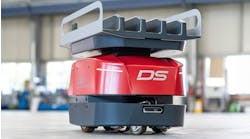Products and services that create actionable data are increasingly tied to added value. Making a product smart through the human-machine interface, integrated electronics, and connectivity can bring high-margin revenue opportunities.
HMI is the brain of a device, telling it to act when the end-user needs it to. HMI technologies range from the traditional single-touch display mounted on a machine to advanced technologies such as gesture-recognition sensors.
The HMI technology market is on track to become an $11.88 billion space by 2026, and much of its success can be attributed to smart home technology. More and more devices are beginning to use capacitive touch, proximity sensing, natural language processing, and other technologies designed to think, make decisions and learn, in turn, making HMI design and manufacturing front and center in product discussions.
Evolving HMIs and related functionalities are growing consumer demand for smart home devices. In Jabil's 2020 Smart Home Technology Trends survey of 215 IoT decision-makers, 57% of participants said opportunities for connected home solutions have more than doubled in the previous two years. Furthermore, production and development of these devices across every category had increased in the same timeline.
The Fitness Industry’s Example
The fitness industry is one area of opportunity for connected home solutions, particularly since the pandemic lockdowns elevated consumer awareness of the range of options available for “fitness from home.” Fitness industry trends are leaning toward “smarter” equipment with more intelligent and integrated electronics.
Fitbits and Apple watches were once used primarily at the gym; now we have connected home equipment that measures our blood pressure, our heart rate, calories burned, and more. Peleton’s in-home fitness equipment connects with remote, live trainers in real-time.
We’re seeing the future of intelligent solutions that combine wearable with the world. Wearable devices like smartwatches, body monitors, and fitness trackers can send a signal to the user’s smart home network when they enter the perimeter of their home. The device can act according to that signal by powering up the living room lights, TV or air conditioner. What makes all this possible: HMI design.
Design Essentials
Modern HMI design for the smart home requires a clear understanding of the device’s users, to understand preferences, anticipate needs, and respond to dynamically changing actions.
Early on, product engineers should decide on the visual language of the IoT device. For instance, should the device use icons or colors? It's vital that users be able to operate the device intuitively.
Status indication is also essential. It's not only about determining whether a device is on or off; it must perform many other functions and understand the end-user on a sophisticated level. An electronic status indicator signals a function of a device with the end-user. Light can shine through the device and communicate in multiple ways: light pipes, panel mount indicators or capacitive touch sensor displays. Such indicators play a big role in how well or poorly an end-user engages with a smart home product.
Engineers also need to consider communication functionality in HMI system design. Usually, the less text and the more visual cues used for the HMI, the easier it is for the consumer to understand it. The brain processes visuals faster than text, so using visuals instead of words whenever possible can ramp up visual communication and eliminate language barriers.
Form follows function. Many smart home and appliance brands want to start the design process by creating device aesthetics. However, it's wise for engineers to keep a clear focus on the actual device interface first. The user interface and user experience of a device are most important when designing smart home products.
When designing a human-machine interface, keep these design tips in mind:
- Provide real-time feedback in the design process to help reverse or rectify a situation.
- Include incremental safety-critical steps instead of having them all take place on the same screen or at once.
- Differentiate between the error messages involved with overriding safety-critical and non-safety-critical actions.
- Ensure tasks require some level of active involvement from the end-user while minimizing repetitive or passive actions.
Once the interface design and HMI software are complete, engineers can focus on the HMI aesthetics. After all, the look and feel of an HMI is what initially attracts a consumer to a product and will impact user experience, satisfaction, and customer loyalty.
Material Considerations
Smart home and appliance engineers utilize many materials during HMI development, including:
- Stainless steel: Exceptionally durable and has improved corrosion resistance. It's usually chosen for its visual appeal. Engineers usually use it because of its laser-fused profiles.
- Composites: Available in an assortment of colors and finishes and are highly usable in flat front panels.
- Carbon fiber: Offers an incredibly high strength-to-weight ratio and is much more durable than stainless steel, but only one-third of the weight.
- Fiberglass: A polymer composed of a plastic matrix reinforced by fine fibers of glass that is lightweight, solid, less brittle, and more expensive than carbon fiber and glass. It will not rust, which makes it great for the outdoors.
- Glass: A high-quality material with great mechanical and optical properties. Very few companies have the equipment large enough to handle large pieces of glass, making it a costly option for smart home and appliance companies.
- Plastic: High-tooling costs make plastic material cost-effective when ordered in larger quantities. It is resilient, energy-efficient, and lightweight.
The choice of materials and finishes can significantly impact the strength, durability, and suitability of HMI technology. But to make HMIs smart, the right connectivity infrastructure must be realized. The smart home industry is poised for an extended wave of growth post-COVID-19 as devices will further automate, monitor, and control our personal, individual environments. Whether it’s called the “smart home” or “digital home,” it is the hub of activity for HMI, connectivity, and sensor solutions. Today’s smart home technology only scratches the surface of what’s to come as the market continues to make great strides toward a full ecosystem of technologies that are working together.
Andrew Glickman is the director of strategic development for the Smart Home and Appliances sector at Jabil. He has been with Jabil over the past 10 years across many functions and roles, including business development, business units, strategy and engineering. He holds an executive MBA from Wharton School of Business and undergraduate and MBA degrees from the University of South Florida.










